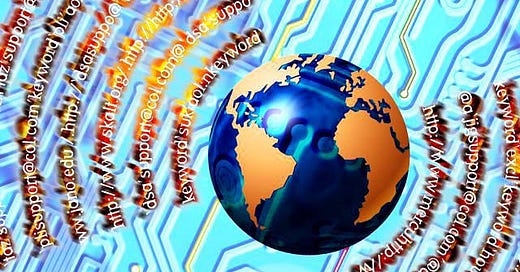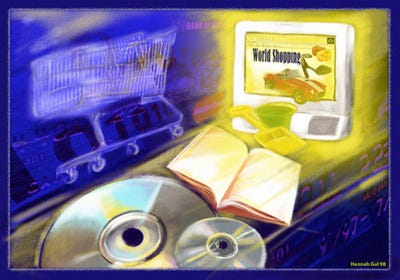I’m from a very specific generation, the first one in which learning how to use the open Internet was a skill taught in childhood. There’s not much that’s good about being from this generation (I will never own a house, be out of student loan debt, and the idea of having children takes on an air of fantasy) but at least I learned how to be proficient at the computer. This proficiency was out of necessity. You see, back in the days before total market saturation, the big tech companies had an incentive to educate. They couldn’t sell a technology people were so intimidated by. Classes were taught in schools, libraries, and community centers, and a cottage industry of computer instruction sprung up everywhere. A wealth of educational materials flooded the market targeted towards new computer and Internet users, which, in the early 1990s, was pretty much anyone not working in a previously computerized industry. Some of these were even for children:
The Internet of the 1990s and 2000s and the Internet of the present couldn’t be more different. Both the early and middle Internet shared a commonality of being mostly decentralized and much less closed-source than it presently is under platformization. While so many of us are nostalgic for this now, in an era when five corporations own the entire web, at the time it was a double-edged sword. In some ways, the basic HTML and blinking GIFs Internet of the past was utopian in scope — millions of people learning how to express themselves and communicate with one another in real time, each around a certain skill level. But in other ways, it was an experimental void in which a mix of anonymity and technological prowess could be used not to contribute knowledge or become better-connected but to exploit those just figuring out how to use this brand new technology. Later, when the Internet reached more people, when it evolved into more expansive communities, blogs, content aggregators and early social media sites such as YouTube or MySpace, and when storage space became more conducive to hosting big files, threats and dangers adapted to this new environment in ever-more savvy ways.
In other words, the old Internet was not exactly safe. This was especially true during the Windows XP era when that operating system achieved an unprecedented and long-lasting market share, making it a common target. Pop-up ads, scams, drive-by downloads, and wretched computer viruses were extremely common. If you ended up somewhere you weren’t supposed to, the consequences could be dire: your computer would be crippled, hijacked and made slow; sometimes you could even lose everything, all from clicking a link you weren’t supposed to. People my age (30) remember this well. It was a rite of passage in those days to give your family computer a particularly terrible virus (such as one of those fake anti-virus programs that is actually malware) while trying to download custom content for The Sims 2.
Hence, because of this fraught webscape, by the age of ten, I knew how to clean up after these kinds of messes — going into the registry, system restoring, booting the computer into Safe Mode so as to run an anti-virus or uninstall a harmful program — all of which required understanding on a basic, structural level, how the computer worked. But more importantly, I learned how to avoid getting into all that trouble in the first place by being able to spot suspicious search engine results, inspect links, and generally discern through visual cues and precedence what parts of online seemed legitimate versus illegitimate. I practiced what is sometimes called Internet hygiene.
While computer viruses never stopped being a threat (everyone should still employ the services of an antivirus software) the nature of that threat has changed. Organized hackers are less interested in giving your PC a fake antivirus and more interested in targeting large scale legacy systems such as those used in governments, hospitals, and corporations. Rather than THEMATRIX_(1999).mov.exe, social engineering, ransomware, click fraud, cryptojacking, and data leaks are the orders of the day. Meanwhile, the platformized, app-driven Internet, through moderation and centralization, have made websites into closed systems more impervious to old-school threats such as pop-up ads or drive-by downloads. New Internet-based licensing protocols (increasingly based on monthly subscriptions instead of one-time software licenses) such as Adobe Creative Cloud and Steam, and streaming media services such as Spotify and YouTube that provide swaths of content for little to no cost have not only decimated physical media (and price gouged creators and users alike) — they’ve also chipped away at piracy and the once-overwhelmingly common practice of peer-to-peer sharing, another virus hotbed. Ad-blockers, while a wicked problem for the old-web economy of click-based revenues, also do their part in keeping users safe.
I can remember very clearly when I stopped being able to use the computer. It was around 2012, when I switched to MacOS, which (I feel) is a much less transparent operating system than Windows, one that held less of a market share and was thus less commonly targeted by widespread Internet booby traps. (This is not to say Macs don’t get viruses — they absolutely do.) Meanwhile, Internet consumption shifted to smartphones, and the app-based ecosystem only reinforced the closedness and opaqueness of platforms as other websites gradually disappeared. I myself have no idea how a smartphone works, nor the full extent to which my data is being tracked. In fact, we are so inured to sharing data that the very concept of Internet (and personal) privacy itself is eroding more and more. As a result of these massive transformations, computer and Internet usage have been remarkably deskilled among ordinary users. The knowledge of how the Internet or an operating system works, things that used to be necessary simply for using both, has become obfuscated and, as a result, relegated to those in the privatized technology sector.
Now, however, the Internet is changing massively yet again. The premature unleashing of AI and large language models (LLMs) in particular onto the open Internet is already having dire consequences for what were, for years, considered stabilized, centralized (if flawed) systems, such as the search engine. AI, thanks to the scope of its spread, its rogue unreliability (it lies — often), the way it poisons search results, hijacks SEO, and is increasingly being used for disinformation and fraud, is reintroducing a fundamental and destabilizing distrust back into the Internet. Once more, I can no longer trust the results Google provides me. On a daily basis I have to ask myself increasingly familiar questions: Is this first result a legitimate news source? Is this image of a protest real? Is that picture of a Kandinsky painting really his or is an AI forgery of his work? Across the board, it’s becoming increasingly hard to tell. For me and countless others, what used to be rote Internet usage has now turned into a nightmarish amount of wasted time spent discerning what is and isn’t real. As far as I, the ordinary user, am concerned, AI is evolving not into a life-changing and labor-saving technology as was promised by its capitalist overlords, but rather into a form of malware that targets, whether unwittingly or not, critical Internet infrastructure.
The problem is, the deskilling of Internet usage has made many users helpless against this new threat. While it’s (barely) possible for the savvy among us to use prior knowledge of existing resources and databases, or search engine filters (e.g. by date) to avoid AI-generated content, the more AI becomes enmeshed in critical infrastructure, the more we will once more have to develop a new type of Internet hygiene out of necessity. As I had to navigate this new web more and more, I began noticing that being able to tell the signs of whether a publication is legitimate or AI slop was not so different on its face than being able to tell whether that link to a repository of videogame content is giving virus. AI generated content has a visual and rhetorical trace that is becoming more and more consolidated as the software feeds on its own entrails. Just like landing pages with five DOWNLOAD links and janky websites gave pause in the aughts, fake journalism sites that didn’t exist before 2021 and are just ads and links should give pause now.
The good news is, we’ve developed Internet hygiene before and we can do it again. Faced with this threat, new guides to healthy and safe Internet use will have to be written for the common user — especially since it looks like the big tech companies aren’t going to do anything to stem the rot. This is a project that should, in a just society, be taken on by libraries and other public outreach programs. Universities and schools should develop curricula not about how to use or embrace AI but to teach a new form of Internet literacy and usage protocol in order to protect students from scams and disinformation. Hopefully, new tools — a kind of AI anti-virus — will be developed to block AI’s web crawlers or even scan for ersatz content, though this might be wishful thinking considering how the technology works. This task will become especially critical in fields such as medicine, engineering, and law, where AI poisoning has the potential to cause incredible damage that puts human life at risk. But first, all of this requires actually recognizing the existential, infrastructural threat AI poses to the tools modern society now runs on. Those systems faced threats at the dawn of their creation that were no less existential. Call me nostalgic, but the old-school virus prevention framework, I think, is a helpful and time-tested one.
Finally, as terrible as the AI infection of the Internet at large is, perhaps a re-skilling of the computer-using population is a silver lining. After two generations of Internet illiteracy, an embrace of new tools for empowerment and understanding can help salvage not only the Internet (if such a thing is still possible) but maybe even some of that old utopianism it once promised. At its core, the computer and the Internet are tools for creation, education, commerce, play, and communication. We as a society shouldn’t have to throw the baby out with the bathwater.





